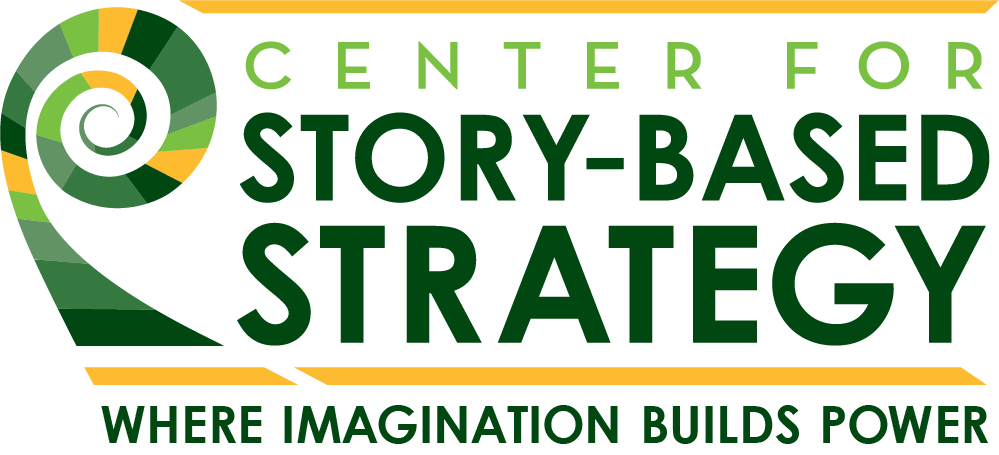Storyboarding Justice: Saa’un P. Bell on story-based strategy and the leaders we need
Saa’un P. Bell, 2020 CSS Fellow
Describe yourself in three words.
Pass.
Tell us about yourself.
I’m an organizer, strategist, writer and creator — an alchemist. I organize young people in public education.
Tell us about the work you brought into your Fellowship. Explain to us why you are doing this work.
In 2020, California had the most significant opportunity to create structural economic change through Proposition 15. This opportunity was made possible from 20 plus years of collective organizing. The proposition would have closed a loophole that big corporations like Chevron and Disney have taken advantage of for 40-plus years.
Artwork by Edson DiAngello
Closing the loophole will generate billions of dollars in revenue. This revenue would rightfully return to schools and local services like public transportation, fire management services, mental health, and more. The Radical Imagination fellowship created the space to take this story and opportunity about structural economic change and create a narrative where California’s young people — young voters of color — come together to tap into our power, beat back corporations, and win structural change.
As a community member, youth organizer, and Senior Strategy Director at Californians for Justice (CFJ), I wanted to explore using Radical Imagination to have a real impact on this issue. And I love graphic novels, comics and science fiction. So I worked with leaders & CFJ alum to script out and storyboard a vision for economic justice from CFJ’s Radical Dreams project that was intentionally placed in the 90s because the issues we face today are deep and cyclical. It will be released in weekly editions leading up to the election.
How to get involved?
Stay tuned. We were within 2 percentage points of winning structural economic change despite being outspent 15-plus million dollars in the last weeks of the campaign. We’re looking at a Fall 2021 release. In the meantime follow Californians for Justice @Cal4Justice and me @Saa_un on the gram.
How would you describe Story-based Strategy (SBS) to someone who has never heard about it?
Artwork by Edson DiAngello
The way that I described the Story-based Strategy to young people and youth organizers who are hearing it about SBS for the first time is to ground ourselves in what we do as organizers.
At CFJ, we organize young people, build a base, and build power to win policies that change our material and social conditions. Now, apply that framework to how we engage, organize, and tap into our imaginations and push the boundaries of what is possible. It is through the collective and individual imaginations & stories we articulate with, and to, each other and to policy producers that become the guideposts of our vision to change our material conditions and build power.
How did SBS affect your work on the project?
In the context of the Schools and Communities First campaign, it got me thinking about cultural and narrative interventions. How can we tap into creativity and story to engage young voters to witness their agency and power in changing electoral outcomes, and hence building power to change our personal and communities’ material conditions.
How was working on this project, using SBS, different from your work without SBS?
Artwork by Edson DiAngello
The most significant difference is that this project created a space to experiment. More importantly, provided resources to be able to do that experiment. This is important because internalized white supremacy and capitalism within non-profit organizing structures will have you thinking that there are a set of tactics that work. Still, the truth is that white supremacy and racism are constantly rearticulating itself to respond to how we organize. While the pacing of transformation can be slow at times and fast in crisis times, it’s essential to underscore how narratives and cultural production can catalyze the kind of change we want and aspire toward in our communities. This project provided the space to really think about how a different tactic can move young people to vote while also engaging members on the narrative arc and characters of the story.
If you could have another iteration of your work, how would it have changed?
Artwork by Edson DiAngello
I would start earlier, earlier than planned. There are considerable variables when doing a project at this scale, especially when your project is a graphic comic bordering on a novel. On average an artist produces 2-6 pages of visual content a week. A skilled artist price per page can range from $150-$300. You have to plan accordingly. That means your script needs to be final. After the script is final, the writer, and/or the artist has to storyboard the script– creating thumbnails to translate the story. And there are so many other steps that take a lot of time. The second thing would definitely be investing in a few artists who can submit model sheets and maybe thumbnail a few pages to ensure that the particular art executes the vision of the story. These things really matter, and it takes time, time that you cannot shortcut unless you are both the writer and artist. Ultimately the artist we chose didn’t pan out as we started to get back sketches of the story.
Do you think SBS will change how you relate to future work in collaboration with others? How? And why?
Story-based Strategy has and will forever be a core part of my organizing, strategy and creative work. I will continue to use SBS in how I think about cultural-political interventions to expand our imaginative thinking, but also reaffirm the will and principle that “we are leaders we need to have communities and schools we deserve''.





